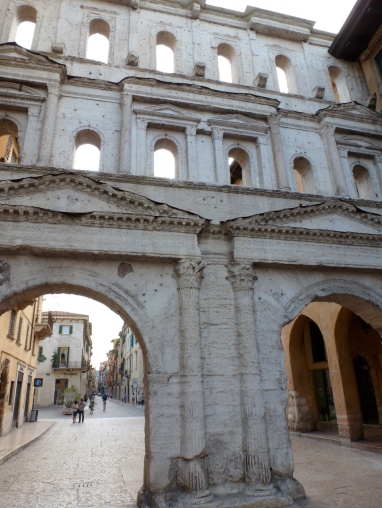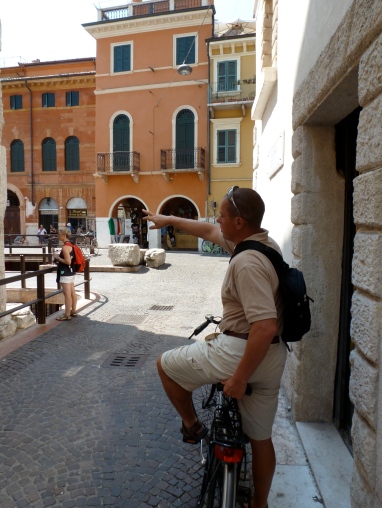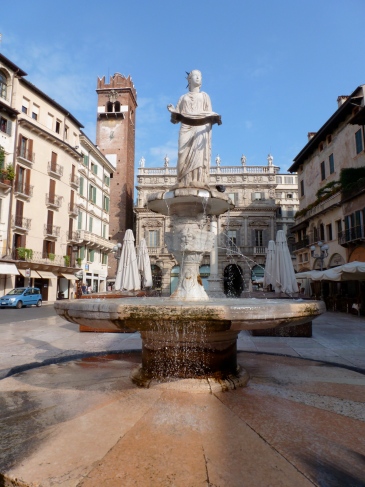We had never met Luca Canever before, but a delightful gem of a man fell into our laps. His layers of historical knowledge gave us multi-faceted insight into Italian history and showed us something new about ourselves.
Luca and I had exchanged a few notes via Facebook after he had read “Don’t Treat My Daughter Like a Dog,” one of my earlier TED WORDS posts, and he had kindly offered to show me and Melissa his beloved home city of Verona. I knew that he practiced positive reinforcement principles, both as a dog trainer and a TAGteacher, but I didn’t know much more. Even though I’d seen a few of his posted photos, I wasn’t too confident about picking him out of a crowd. I wondered if he might more easily identify us: Ah, si, si, si. The two bleary-eyed Americans just stepping down to the platform. I need not have worried. As we pulled into the Verona station, I spied a sturdy-looking guy with a safari shirt, khaki shorts, and a warm smile that suggested a spirit of adventure. Our own Indiana Gionzi, this had to be him.
Sure enough, as soon as we got off the train, Luca strode straight for us, extended his hand to me for a hearty handshake and offered Melissa a traditional, Italian double-peck greeting. He helped us store our luggage for the day–thank goodness for someone to do the bilingual heavy-lifting when we were so fatigued!–and then treated us to a bus ride into the historic part of town. As we enjoyed a light Italian breakfast in the shadow of a huge Roman arched wall that marked the entrance to the city, we learned that Luca was more than just a friendly tour guide. He is also a trained archaeologist, one called into construction sites to make sure that ground-breaking projects don’t disturb or mar precious historical remnants. Really, who better to lead us around?
After we finished at the cafe, Luca led us down a few cobblestone alleys to a little inn where he had reserved some rental bikes for us. (Clearly, this guy meant tour-giving business.)
From there, we began our whirlwind tour in earnest. Like a Pied Piper, Luca paraded us over bridges, along the banks of the Fiume Adige, into churches from the time of early Christianity, up the hill to a palace that provided stunning views of the city, and across piazze brimming with market vendors, open-air cafeterias, and throngs of tourists. We stopped to catch our breath every so often, enjoying a spritz at a cafeteria and an amazing vegan lunch at an organic foods restaurant, but mostly we soldiered on, and eagerly so. For our last stop, Luca took us to the massive and multi-tiered Arena, home to the grisly entertainment of the Roman days and to the more refined culture of current-day theater and opera productions. In just a few hours, we’d gotten a great taste of the many treasures that Verona holds.
Several sites in particular demonstrated the city’s uniquely complex history. One of the most fascinating was a fountain in the central square. A Roman pedestal serves as the base, supporting a catch pool sculpted during medieval times. Above that, the Roman body of a goddess rises up, leading to an oddly balanced, again medieval head above it. The people of Verona have neither destroyed their past nor ignored it. Instead, they have patched it together in a way that makes sense for them.
At another spot, Luca showed us a parking lot. “Can you figure out what’s special about this location?” he quizzed. We answered the only way we knew how, embracing the full extent of our ignorance: “Uh, that there’s a parking lot?” We weren’t too far off. The asphalt covered a site that had been designated for constructing a several-stories-deep underground parking garage. When the builders did their requisite archaeological study, however, they found Roman ruins. Rather than disturb them further, they covered them back up and left the single surface-level lot. I loved that Luca knew these specifics.
The precious San Stefano church proved my favorite location of the day. Built in the 4th century on a site that had earlier housed a Roman temple, the modest space offers an oasis of cool and calm from the summer bustle outside. Enough sun shows through upper-level windows to throw light throughout, but not so much to ruin the sacred mood. Gorgeous paintings on the walls and ceiling use bolder reds and darks that blend smoothly with the softer pinks and tans of the stonework around them. Intricate accent decorations somehow manage to be both humble and ornate, showing clearly the passion and vision of the artists who crafted the place.
- Lovely Verona.
The church’s imperfections–fading paintings, worn floor stones, disparate elements added from different time periods–actually made it more perfect to my eye, each subtle “off” quality making the space more unique. “If you go to many German churches,” Luca explained, “they’ll repaint almost every year to keep the art looking fresh. We prefer to let the paintings show their time.”1
All of Verona seems a fascinating analogy for the self. The city combines layers from Roman, medieval, Renaissance, and modern times, each adding a flavor and quality of its own to the larger whole. We, of course, carry a similar conglomeration of stories from our pasts that make up who we are. Some of us try to deny the past, refusing to see the beauty and preciousness of every element, even those fading from memory. Others of us try to cling to what came before, resisting the influence or perspective offered by contact with new forces and fresh insights. Few among us find a balanced sweet spot that makes peace of the many pieces.
Sometimes, the harmony we seek can mean having to let some history go. Though he’s from Verona and loves the past dearly, I think Luca would agree. At that re-covered parking lot where we stopped, I had wondered why, if the developers weren’t going to bother uncovering and honoring the ruins that they found, didn’t they just choose to build the new structure anyway? In essence, the decision-makers had decided that that specific past–those Roman ruins–had no future. In that case, I figured, the site wouldn’t ever be seen anyway. Why not accept that decision in full and go forward with the project? Luca acknowledged the question, adding “Yes, it’s tricky to know the right timing, but sometimes it is best to let the past die.” For every Roman Road that marks the original boundaries of a town–or the central core of a self–the past can serve up dozens of trash piles without import. Not all traumas deserve unearthing. Not all nostalgias add value.
As with Verona’s layers of history, so too with ours. We can each play archaeologist with our own pasts–and sometimes we might have the therapeutic help of a knowledgable guide like Luca–but it’s tough to know which layers to preserve or display and which to let fade. Teachers and students, family and friends, singles and spouses alike: we all share the same challenge. Perhaps it’s enough to recognize that we have multiple layers at all. We do contain more complexity than what’s seen on the surface. We can never be explained by one moment or event. Acknowledging that swirls of history will always wear parts of us away, we can trust that the erosions and imperfections that emerge will create a beauty uniquely ours.

Lovely Verona.







🙂 Would have love to have shared THIS day:))